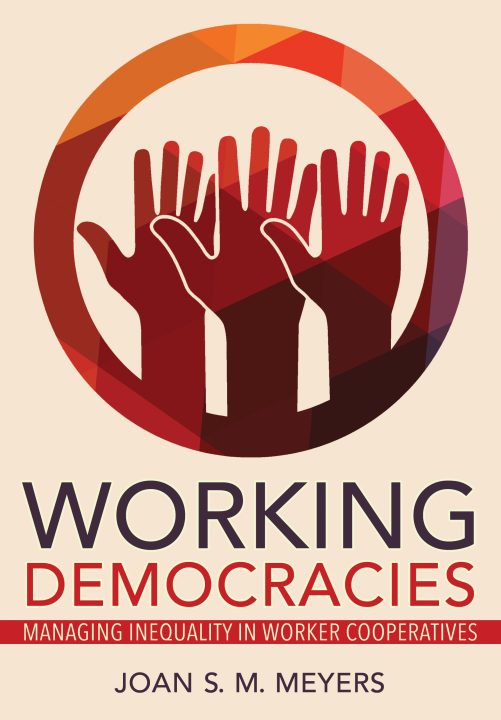Working Democracies: Managing inequality in worker cooperatives, Joan S. M. Meyers, Cornell (ILR Press)
After welcoming the millennium with some over-excited talk of the “end of history”, the world has been rocked by a string of harrowing economic, political and environmental crises – and a publishing industry has grown up around diagnosing the problem. Co-op thinkers have their own perspective on the global malaise and the questions it raises around equality, ownership, power and identities of race, gender and class.

Enter Joan Meyers with a look at worker co-ops – increasingly presented as a democratic grassroots rival to the prevailing populist and corporate forces.
Worker-led models, touted as a counter force to tech monopolies like Amazon, have been slowly moving from the pages of publications like Co-op News to the mainstream press, a process which took another big step in recent weeks with the revelations about the corporate behaviour of Uber, making this a timely book.
But even worker co-ops face questions around equality, ownership, power and identity, says Meyers, an associate professor at California Polytechnic State University. She looks at how they play out in two lengthy, intensive case studies of North Californian worker co-ops – People’s Daily Bread Bakery and One World Natural Grocery – prompted by a conference clash between members of the two organisations over class and management.
Herbert Gubbins, CEO of the bakery, favoured a formal business structure over participative self-management because his team are “working-class people who want to come in, do their job, and get home to their families. They don’t want to sit through endless meetings.”
But Jan Bridges, from the grocery, responded by telling Meyers: “All kinds of working class people run their own businesses every day.”
Meyers, struck by “two strikingly different views of what workers want, decided to investigate further, and has compiled a fascinating comparative study of the two co-ops, with frank testimony revealed through interviews and minutes from meetings.
She discovered that “almost all of the members of both co-operatives shared similar levels of personal and family education, family wealth and occupational prestige, and ‘class culture’,“ but there were differences.

“While the grocery had preserved its gender balance,” she notes, “bakery women were a small minority, and power and authority mapped onto race/ethnicity at the bakery in a way not found at the grocery.”
A co-op’s structure makes a difference here. Both organisations brought in consultants to help them weather the financial crises of the 1980s. They went “in opposite directions from their collectivist origins”, says Meyers: the bakery adopted a permanent and positional management supervised by a board of directors elected from the membership, and the grocery opted for the “formalisation and increased coordination of highly decentralised work group self-management”.
Worker co-ops, adds Meyers, face “inherent tensions” in a capitalist market – with worker-owners forced to walk a line between protecting their capital and ensuring that all members are justly rewarded for their labour. Worker democracy must be reconciled with “the need for delegation and coordination of authority in order to compete successfully with nondemocratic firms”, while “the different market values of members’ skills … conflicts with the equity orientation of the worker co-operative project”.
These tensions are acute when it comes to the current push for racial and gender equity, argues Meyers. “The current period of worker co-operative expansion sits uneasily with co-operatives’ desire to meet their workers’ needs, particularly given the US reconfiguration of so-called working-class (manual and service) jobs as far more Black, Brown, and women.”
Part of the problem lies in the roots of worker co-ops, whose “organisational scale and process limited profitability”, can lead to “poverty wages, effectively excluding people who were unable to fall back on loans or gifts of family wealth”. Another issue is the greater ease for white people in terms of accessing personal networks or assuming control of informal structures – informal structures which, warns Meyers, can confer “almost limitless authority”.
Another barrier is the accepted perception of the working class as white, industrial and male in ways that “undermine the legitimacy of others”.
For all that, Meyers values the movement. “Labour is under attack. It needs worker co-operatives,” she says, valuing them as part of a wider social and solidarity economy: “diverse organisations and practices as powerful constituents of an enlivened noncapitalist politics of place”. At both co-ops, she finds a lack of class inequality – good wages, with pay equity between gender and racial groups; working class hirings; and, at the bakery at least, a ethnic diversity much improved from the counterculture days.
And when she ponders the alarming problems facing the world – from rising inequality and environmental destruction to the rise of authoritarianism – she is pleased to find “worker cooperatives [which] were able to resist the naturalisation of inequality”.
She still frets that worker co-ops might only offer “temporary shelter” in a world which forces workers to become “possessive, fiercely guarding their gates against those perceived as invaders and outsiders”. But Meyers is no determinist: noting that “there are conditions under which working people will choose to share rather than hoard, to recognise rather than pave over differences and divisions, to address rather than exploit privilege and disadvantage”, she says humanity chooses its future.
“Without the active participation of all working people, those choices will likely be for continued exploitation. But another world – co-operative and egalitarian – is indeed possible.”